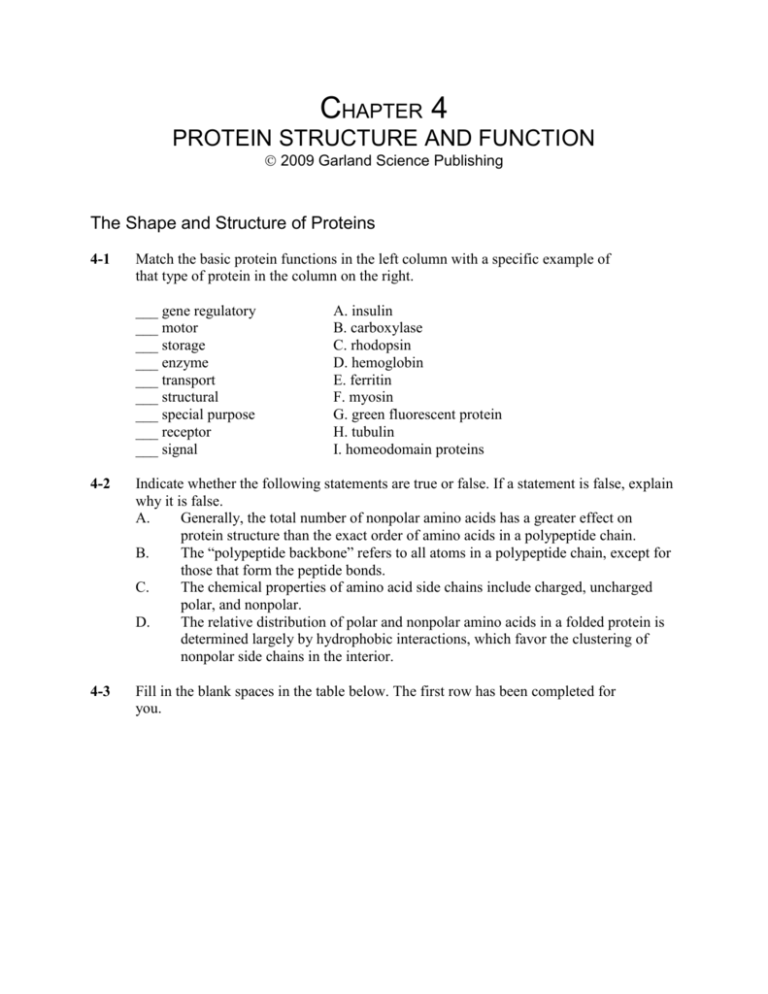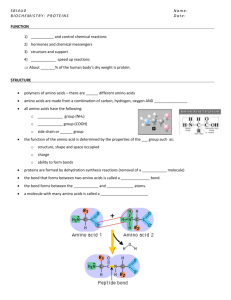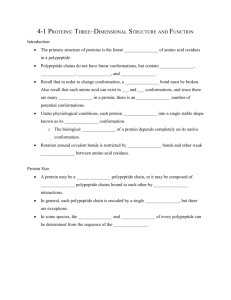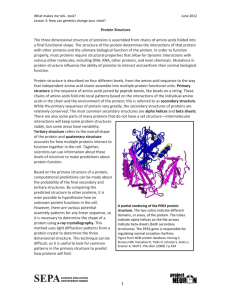Chapter 3: Energy, Catalysis, and Biosynthesis
advertisement

CHAPTER 4 PROTEIN STRUCTURE AND FUNCTION 2009 Garland Science Publishing The Shape and Structure of Proteins 4-1 Match the basic protein functions in the left column with a specific example of that type of protein in the column on the right. ___ gene regulatory ___ motor ___ storage ___ enzyme ___ transport ___ structural ___ special purpose ___ receptor ___ signal A. insulin B. carboxylase C. rhodopsin D. hemoglobin E. ferritin F. myosin G. green fluorescent protein H. tubulin I. homeodomain proteins 4-2 Indicate whether the following statements are true or false. If a statement is false, explain why it is false. A. Generally, the total number of nonpolar amino acids has a greater effect on protein structure than the exact order of amino acids in a polypeptide chain. B. The “polypeptide backbone” refers to all atoms in a polypeptide chain, except for those that form the peptide bonds. C. The chemical properties of amino acid side chains include charged, uncharged polar, and nonpolar. D. The relative distribution of polar and nonpolar amino acids in a folded protein is determined largely by hydrophobic interactions, which favor the clustering of nonpolar side chains in the interior. 4-3 Fill in the blank spaces in the table below. The first row has been completed for you. 4-4 Fully folded proteins typically have polar side chains on their surfaces, where electrostatic attractions and hydrogen bonds can form between the polar group on the amino acid and the polar molecules in the solvent. In contrast, some proteins have a polar side chain in their hydrophobic interior. Which of following would not occur to help accommodate an internal, polar side chain? (a) A hydrogen bond forms between two polar side chains. (b) A hydrogen bond forms between a polar side chain and protein backbone. (c) A hydrogen bond forms between a polar side chain and an aromatic side chain. (d) Hydrogen bonds form between polar side chains and a buried water molecule. 4-5 To study how proteins fold, scientists must be able to purify the protein of interest, use solvents to denature the folded protein, and observe the process of refolding at successive time points. What is the effect of the solvents used in the denaturation process? (a) The solvents break all covalent interactions. (b) The solvents break all noncovalent interactions. (c) The solvents break some of the noncovalent ineractions, resulting in a misfolded protein. (d) The solvents create a new protein conformation. 4-6 Which of the following statements is true? (a) Peptide bonds are the only covalent bonds that can link together two amino acids in proteins. (b) The polypeptide backbone is free to rotate about each peptide bond. (c) Nonpolar amino acids tend to be found in the interior of proteins. (d) The sequence of the atoms in the polypeptide backbone varies between different proteins. 4-7 For each of the following sentences, fill in the blanks with the best word or phrase selected from the list below. Not all words or phrases will be used; each word or phrase should be used only once. A newly synthesized protein generally folds up into a __________________ conformation. All the information required to determine a protein’s conformation is contained in its amino acid __________________. On being heated, a protein molecule will become __________________ as a result of breakage of __________________ bonds. On removal of urea, an unfolded protein can become __________________. The final folded conformation adopted by a protein is that of __________________ energy. composition covalent denatured highest irreversible lowest noncovalent renatured reversible sequence stable unstable 4-8 The correct folding of proteins is necessary to maintain healthy cells and tissues. Unfolded proteins are responsible for such neurodegenerative disorders as Alzheimer’s, Huntington’s, and Creutzfeld–Jacob disease (the specific faulty protein is different for each disease). What is the ultimate fate of these disease-causing, unfolded proteins? (a) They are degraded. (b) They bind a different target protein. (c) They form structured filaments. (d) They form protein aggregates. 4-9 The three-dimensional coordinates of atoms within a folded protein are determined experimentally. After researchers obtain a protein’s structural details, they can use different techniques to highlight particular aspects of the structure. What visual model best displays a protein’s secondary structures (α helices and β sheets)? (a) ribbon (b) space-filling (c) backbone (d) wire 4-10 Typical folded proteins have a stability ranging from 7 to 15 kcal/mol at 37°C. Stability is a measure of the equilibrium between the folded (F) and unfolded (U) forms of the protein, with the unfolded form having a greater free energy. See Figure Q4-10: for a protein with a stability of 7.1 kcal/mol, calculate the fraction of protein that would be unfolded at equilibrium at 37°C. The equilibrium constant (Keq) is related to the free energy (G°) by the equation Keq = 10–G°/1.42. Figure Q4-10 4-11 Although all protein structures are unique, there are common structural building blocks that are referred to as regular secondary structures. Some have α helices, some have β sheets, and still others have a combination of both. What makes it possible for proteins to have these common structural elements? (a) specific amino acid sequences (b) side-chain interactions (c) the hydrophobic core interactions (d) hydrogen bonds along the protein backbone 4-12 Which of the following is not a feature commonly observed in α helices? (a) left-handedness (b) one helical turn every 3.6 amino acids (c) cylindrical shape (d) amino acid side chains that point outward 4-13 Which of the following is not a feature commonly observed in β sheets? (a) antiparallel regions (b) coiled-coil patterns (c) extended polypeptide backbone (d) parallel regions 4-14 You wish to produce a human enzyme, protein A, by introducing its gene into bacteria. The genetically engineered bacteria make large amounts of protein A, but it is in the form of an insoluble aggregate with no enzymatic activity. Which of the following procedures might help you to obtain soluble, enzymatically active protein? Explain your reasoning. A. Make the bacteria synthesize protein A in smaller amounts. B. Dissolve the protein aggregate in urea, then dilute the solution and gradually remove the urea. C. Treat the insoluble aggregate with a protease. D. Make the bacteria overproduce chaperone proteins in addition to protein A. E. Heat the protein aggregate to denature all proteins, then cool the mixture. 4-15 Protein structures have several different levels of organization. The primary structure of a protein is its amino acid sequence. The secondary and tertiary structures are more complicated. Consider the definitions below and select the one that best fits the term “protein domain.” (a) a small cluster of α helices and β sheets (b) the tertiary structure of a substrate-binding pocket (c) a complex of more than one polypeptide chain (d) a protein segment that folds independently 4-16 The protein structure in Figure Q4-16 contains four α helices arranged in a bundle. Label each helix by number (1 to 4) starting going from the N terminus to the C terminus, both of which are labeled. List the six possible pairings of these helices, and indicate within each pair whether the helices are parallel or antiparallel. Figure Q4-16 4-17 For each polypeptide sequence listed, choose from the options given below to indicate which secondary structure the sequence is most likely to form upon folding. The nonpolar amino acids are italicized. A. B. C. Leu-Gly-Val-Leu-Ser-Leu-Phe-Ser-Gly-Leu-Met-Trp-Phe-Phe-Trp-Ile Leu-Leu-Gln-Ser-Ile-Ala-Ser-Val-Leu-Gln-Ser-Leu-Leu-Cys-Ala-Ile Thr-Leu-Asn-Ile-Ser-Phe-Gln-Met-Glu-Leu-Asp-Val-Ser-Ile-Arg-Trp amphipathic α helix hydrophobic α helix hydrophilic β sheet 4-18 hydrophilic α helix amphipathic β sheet Figure Q4-18 shows a fatty acid binding protein from two different angles. Apart from its two short α helices, its structural elements are extended strands that form a curved β sheet, which is called a β barrel. Draw arrows on the six top strands in panel (A) (those running horizontally) to determine whether the β barrel is made up of parallel or antiparallel strands. Look at panel (B) and predict the relative distribution of polar and nonpolar side chains (inside the barrel or outside the barrel) and explain your answer. Figure Q4-18 4-19 Drawn below are segments of β sheets, which are rigid pleated structures held together by hydrogen bonds between the peptide backbones of adjacent strands (Figure Q4-19). The amino acid side chains attached to the Cα carbons are omitted for clarity. Figure Q4-19 A. B. 4-20 For panel (A) and for panel (B), indicate whether the structure is parallel or antiparallel. Draw the hydrogen bonds as dashed lines (- - - - - -). For each of the following sentences, fill in the blanks with the best word or phrase selected from the list below. Not all words or phrases will be used; each word or phrase should be used only once. The α helices and β sheets are examples of protein __________________ structure. A protein such as hemoglobin, which is composed of more than one protein __________________, has __________________ structure. A protein’s amino acid sequence is known as its __________________ structure. A protein __________________ is the modular unit from which many larger single-chain proteins are constructed. The three-dimensional conformation of a protein is its __________________ structure. allosteric domain helix ligand primary quaternary secondary subunit tertiary 4-21 In an attempt to define the protein domains of protein X, you treat it with a protease and use polyacrylamide gel electrophoresis to analyze the peptides produced. In the past, you have used chymotrypsin to perform this experiment, but the stock of this enzyme has been used up . You find a stock of elastase and decide to use it instead of waiting for a new stock of chymotrypsin to arrive. A. Give two reasons why elastase is a good substitute for chymotrypsin in this assay. B. Why might proteolysis of the same substrate by chymotrypsin or elastase yield different results? 4-22 You are digesting a protein 625 amino acids long with the enzymes Factor Xa and thrombin, which are proteases that bind to and cut proteins at particular short sequences of amino acids. You know the amino acid sequence of the protein and so can draw a map of where Factor Xa and thrombin should cut it (Figure Q4-22). You find, however, that treatment with each of these proteases for an hour results in only partial digestion of the protein, as summarized under the figure. List the segments (A–E) of the protein that are most likely to be folded into compact, stable domains. Figure Q4-22 4-23 Calculate how many different amino acid sequences there are for a polypeptide chain 10 amino acids long. 4-24 You have produced a monoclonal antibody that binds to the protein actin. To be sure that the antibody does not cross-react with other proteins, you test your antibody in a western blot assay on whole cell lysates that have been subjected to electrophoresis under nondenaturing conditions (shown in Figure Q4-24A) and denaturing conditions (shown in Figure Q4-24B). Does the antibody cross-react with other proteins? If so, does this explain the results in the two western blots? If not, how do you explain the differences observed? Figure Q4-24 4-25 Examine the three protein monomers in Figure Q4-25. From the arrangement of complementary binding surfaces, which are indicated by similarly shaped protrusions and indentations, decide whether each monomer could assemble into a defined multimer, a filament, or a sheet. Figure Q4-25 4-26 For each of the following indicate whether the individual folded polypeptide chain forms a globular (G) or fibrous (F) protein molecule. A. keratin B. lysozyme C. elastin D. collagen E. hemoglobin F. actin 4-27 Globular proteins fold up into compact, spherical structures that have uneven surfaces. They tend to form multisubunit complexes, which also have a rounded shape. Fibrous proteins, in contrast, span relatively large distances within the cell and in the extracellular space. Which of the proteins below is not classified as a fibrous protein? (a) elastase (b) collagen (c) keratin (d) elastin 4-28 You have two purified samples of protein Y: the wild-type (nonmutated) protein and a mutant version with a single amino acid substitution. When washed through the same gelfiltration column, mutant protein Y runs through the column more slowly than the normal protein. Which of the following changes in the mutant protein is most likely to explain this result? (a) the loss of a binding site on the mutant protein surface through which protein Y normally forms dimers (b) a change that results in the mutant protein’s acquiring an overall positive instead of a negative charge (c) a change that results in the mutant protein’s being larger than the wild-type protein (d) a change that results in the mutant protein’s having a slightly different shape from the wild-type protein 4-29 Which of the following statements is true? (a) (b) (c) (d) Disulfide bonds are formed by the cross-linking of methionine residues. Disulfide bonds are formed mainly in proteins that are retained within the cytosol. Disulfide bonds stabilize but do not change a protein’s final conformation. Agents such as mercaptoethanol can break disulfide bonds through oxidation. How Proteins Work 4-30 For each of the following sentences, fill in the blanks with the best word or phrase selected from the list below. Not all words or phrases will be used; each word or phrase should be used only once. The human immune system produces __________________ of different immunoglobulins, also called __________________, which enable the immune system to recognize and fight germs by specifically binding one or a few related __________________. The hypervariable structural element that forms the ligand-binding site is comprised of several __________________. Purified antibodies are useful for a variety of experimental purposes, including protein purification using __________________ chromatography. affinity antibodies antigens β strands billions coiled coils hundreds ion-exchange ligands loops size-exclusion 4-31 Proteins bind selectively to small molecule targets called ligands. The selection of one ligand out of a mixture of possible ligands depends on the number of weak, noncovalent interactions in the protein’s ligand-binding site. Where is the binding site typically located in the protein structure? (a) on the surface of the protein (b) inside a cavity on the protein surface (c) buried in the interior of the protein (d) forms on the surface of the protein in the presence of ligand 4-32 Indicate whether the following statements are true or false. If a statement is false, explain why it is false. A. The amino acids in the interior of a protein do not interact with the ligand and do not play a role in selective binding. B. Antibodies are Y shaped and are composed of six different polypeptide chains. C. ATPases generate ATP for the cell. D. Hexokinase recognizes and phosphorylates only one of the glucose stereoisomers. 4-33 Fill in the blanks with the labels in the list below to identify various parts of the antibody structure in Figure Q4-33. A. constant domain of the light chain B. C. D. E. constant domain of the heavy chain antigen-binding site variable domain of the heavy chain variable domain of the light chain Figure Q4-33 4-34 The process of generating monoclonal antibodies is labor-intensive and expensive. An alternative is to use polyclonal antibodies. A subpopulation of purified polyclonal antibodies that recognize a particular antigen can be isolated by chromatography. Which type of chromatography is used for this purpose? (a) affinity (b) ion-exchange (c) gel-filtration (d) any of the above 4-35 Lysozyme is an enzyme that specifically recognizes bacterial polysaccharides, which renders it an effective antibacterial agent. Into what classification of enzymes does lysozyme fall? (a) isomerase (b) protease (c) nuclease (d) hydrolase 4-36 Which of the following mechanisms best describes the manner in which lysozyme lowers the energy required for its substrate to reach its transition state conformation? (a) (b) (c) (d) by binding two molecules and orienting them in a way that favors a reaction between them by altering the shape of the substrate to mimic the conformation of the transition state by speeding up the rate at which water molecules collide with the substrate by binding irreversibly to the substrate so that it cannot dissociate 4-37 Studies conducted with a lysozyme mutant that contains an Asp→Asn change at position 52 and a Glu→Gln change at position 35 exhibited almost a complete loss in enzymatic activity. What is the most likely explanation for the decrease in enzyme activity in the mutant? (a) increased affinity for substrate (b) absence of negative charges in the active site (c) change in the active site scaffold (d) larger amino acids in the active site decrease the affinity for substrate 4-38 For some proteins, small molecules are integral to their structure and function. Enzymes can synthesize some of these small molecules, whereas others, called vitamins, must be ingested in the food we eat. Which of the following molecules is not classified as a vitamin but does require the ingestion of a vitamin for its production? (a) retinal (b) biotin (c) zinc (d) heme 4-39 For each of the following sentences, fill in the blanks with the best word or phrase selected from the list below. Not all words or phrases will be used; each word or phrase should be used only once. Any substance that will bind to a protein is known as its __________________. Enzymes bind their __________________ at the __________________. The enzyme hexokinase is so specific that it reacts with only one of the two __________________ of glucose. Enzymes catalyze a chemical reaction by lowering the __________________, because they provide conditions favorable for the formation of a __________________ intermediate called the __________________. Once the reaction is completed, the enzyme releases the __________________ of the reaction. activation energy active site free energy high-energy 4-40 inhibitors isomers ligand low-energy products substrates transition state One way in which an enzyme can lower the activation energy required for a reaction is to bind the substrate(s) and distort its structure so that the substrate more closely resembles the transition state of the reaction. This mechanism will be facilitated if the shape and chemical properties of the enzyme’s active site are more complementary to the transition state than to the undistorted substrate; in other words, if the enzyme were to have a higher affinity for the transition state than for the substrate. Knowing this, your friend looked in an organic chemistry textbook to identify a stable chemical that closely resembles the transition state of a reaction that converts X into Y. She generated an antibody against this transition state analog and mixed the antibody with chemical X. What do you think might happen? How Proteins Are Controlled 4-41 The biosynthetic pathway for the two amino acids E and H is shown schematically in Figure Q4-41. You are able to show that E inhibits enzyme V, and H inhibits enzyme X. Enzyme T is most likely to be subject to feedback inhibition by __________________ alone. Figure Q4-41 (a) (b) (c) (d) H B C E 4-42 Indicate whether the following statements are true or false. If a statement is false, explain why it is false. A. Feedback inhibition is defined as a mechanism of down-regulating enzyme activity by the accumulation of a product earlier in the pathway. B. If an enzyme’s allosteric binding site is occupied, the enzyme may adopt an alternative conformation that is not optimal for catalysis. C. Protein phosphorylation is another way to alter the conformation of an enzyme and serves exclusively as a mechanism to increase enzyme activity. D. GTP binding proteins typically have GTPase activity, and the hydrolysis of GTP transforms them to the “off” conformation. 4-43 The Ras protein is a GTPase that functions in many growth-factor signaling pathways. In its active form, with GTP bound, it transmits a downstream signal that leads to cell proliferation; in its inactive form, with GDP bound, the signal is not transmitted. Mutations in the gene for Ras are found in many cancers. Of the choices below, which alteration of Ras activity is most likely to contribute to the uncontrolled growth of cancer cells? (a) a change that prevents Ras from being made (b) a change that increases the affinity of Ras for GDP (c) a change that decreases the affinity of Ras for GTP (d) a change that decreases the rate of hydrolysis of GTP by Ras 4-44 Motor proteins use the energy in ATP to transport organelles, rearrange elements of the cytoskeleton during cell migration, and move chromosomes during cell division. Which of the following mechanisms is sufficient to ensure the unidirectional movement of a motor protein along its substrate? (a) A conformational change is coupled to the release of a phosphate (Pi). (b) The substrate on which the motor moves has a conformational polarity. (c) A conformational change is coupled to the binding of ADP. (d) A conformational change is linked to ATP hydrolysis. 4-45 The phosphorylation of a protein is typically associated with a change in activity, the assembly of a protein complex, or the triggering of a downstream signaling cascade. The addition of ubiquitin, a small polypeptide, is another type of covalent modification that can affect the protein function. Ubiquitylation often results in ______________. (a) membrane association (b) protein degradation (c) protein secretion (d) nuclear translocation 4-46 Energy required by the cell is generated in the form of ATP. ATP is hydrolyzed to power many of the cellular processes, increasing the pool of ADP. ADP molecules then bind to glycolytic enzymes, which will lead to the production of more ATP. The best way to describe how oxidation energy is converted to ATP energy during glycolysis is by ___________. (a) feedback inhibition (b) allosteric conformation (c) allosteric activation (d) substrate-level phosphorylation 4-47 Some of the enzymes that oxidize sugars to yield usable cellular energy (for example, ATP) are regulated by phosphorylation. For these enzymes, would you expect the inactive form to be the phosphorylated form or the dephosphorylated form? Explain your answer. 4-48 Which of the following methods used to study proteins is limited to proteins with a molecular weight of 50 kD or less? (a) x-ray crystallography (b) fingerprinting (c) nuclear magnetic resonance (d) mass spectroscopy 4-49 Determining a protein’s sequence, site of covalent modification, or entire threedimensional structure requires the careful analysis of complex data sets. Which of the data sets below would you have to interpret to solve the structure of a protein by using xray crystallography? 4-50 Instead of studying one or two proteins or protein complexes present in the cell at any given time, we can now look at a snapshot of all proteins being expressed in cells being grown in specific conditions. This large-scale, systematic approach to the study of proteins is called _______________. (a) proteomics (b) structural biology (c) systems biology (d) genomics 4-51 Using the example of the p53 protein, explain how different combinations of covalent modifications can lead to a wide variety of protein functions.








